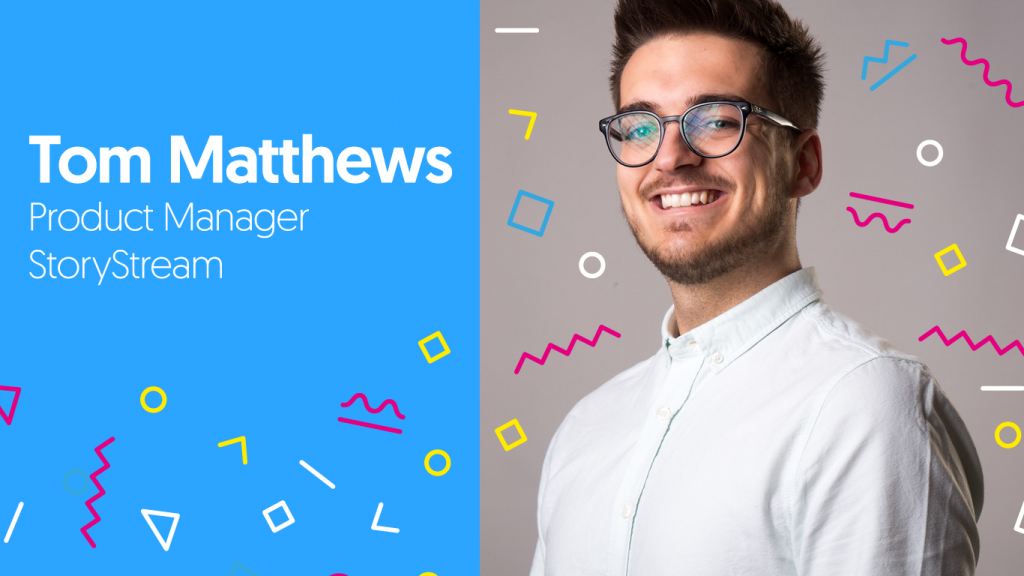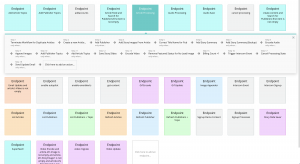Prodcel Stories is a series of interviews with Product & Engineering people. How do their development processes work? What tools they use and how they manage a remote team.
Hello! What’s your background, and what are you working on?
Hi! I owe my (so far, short) background in product to my current company, StoryStream.
I wasn’t sure if I was going to commit to a sandwich course at university, spending a year working before going back to complete my degree – I must’ve changed my mind about once a week during first year!
I’m very glad I chose to do it.
I stumbled across StoryStream, a start-up in Brighton, specialising in user-generated content publishing. The aim for brands was getting Instagram content on their homepages and screens at events.
I started working in the commercial team, and as the company grew and changed focus, so did I.
I started taking courses, reading, learning and eventually moving into the role I never knew I always wanted: Product Manager.
So, just as StoryStream’s focus pivoted to AI-powered content management, I started taking courses, reading, learning and eventually moving into the role I never knew I always wanted: Product Manager.
At the moment our main focus is extending our existing digital asset management (DAM) functionality, so there’s a few customer working group sessions, a lot of functionality specs flying around, and endless roadmap prioritisation going on.
What does a typical week at work look like for you?
Typical working week? Who has one of those!
Our teams work on two-week sprint cycles, so it usually begins with writing specs and ordering upcoming sprint tasks with our Head of Product and Engineering Lead, based on the roadmap.
Once that’s sorted, there’s usually a chocolate and doughnut-fuelled Wednesday afternoon in the Blue meeting room for sprint planning.
We go through the roadmap priorities in Productboard, and tasks are discussed before adding them to our JIRA board in the session. Estimations are added per task rather than feature, as it makes the front/back end split easier, and we can make more accurate predictions about potential velocity for future sprints, quarters etc.
The engineering team play Planning Poker to get a consensus on story point (a combination of effort and time), and once we’ve reached a certain point of availability (informed from previous sprint’s total story points) we call it a day and the team crack on!
Sprints start the first Thursday, as tasks are moved through a Kanban board over the next 9 days, with the second Monday and Tuesday the following week reserved for pull requests and merging code, ready for deployment Wednesday morning.
At the end of each sprint, the teams organise regular retrospectives, which is a healthy environment for the development team to discuss things that we did well, things we didn’t do so well, things we need to start and things we should make an effort to stop.
This is usually a whiteboard job, where the team spend 5 minutes individually writing successes/issues down on post-it notes, placing them under the right heading, ready to be discussed. The Engineering Lead will start to group themes of discussion points, before going through each post-it note, allowing whoever wrote it to talk about it a little bit.
Finally, these are captured as brief bullet points, and added to Confluence.
Next?
We start the whole process again! 🔁
What tools do you use to get your job done?
Aside from email, the tools I use the most are:
Productboard is easily my favourite of the above. It’s (in my opinion) the best way to display a timeline of your company’s feature development, make use of an automatically generated effort/value matrix, and get into the functional details per feature. On top of this, the plans have a very generous number of seats, making sharing this information company-wide very easy.
I do and don’t like Slack. On the one hand, it’s the most efficient way to share information, files and dog gifs. On the other hand, there’s so much dependence on Slack that all process seems to go out the window, and suddenly it’s almost impossible to find that one specific file, called something you can’t remember, that was shared in a long-lost channel.
That said, we’re getting much better at putting content in the right place in our central location, and sharing from there.
Google Docs. Going from emails containing FILENAME_v0.8_FINAL, to what we all know and love today, I just don’t have a bad word to say about it, and with the number of functional specs I need to write it’s a browser tab that’s never not open in my day-to-day.
I really wish Atlassian didn’t have total monopoly over development/process/reporting tools because the software is so bloated that I find it so annoying to navigate, JIRA being the biggest offender.
I would much rather we used a stripped-back Kanban tool to manage our bugs, backlog and sprints, that integrated well with Productboard and Slack. (Let me know if you find one!)
How do you manage working with remote members of your team?
StoryStream has Brighton and London offices, a flexible working policy and the option to work from home, so we often have to work remotely with members of the team.
Another thing Slack does very well (for us, at least) is integrate with nearly every software provider we use. On the topic of remote working, our WFH (‘working from home’) channel works a treat, where the team can drop a message with why they’re working remotely, and a company-wide calendar entry is added automatically.
The status feature is also pretty useful at seeing if your colleague in London is in a meeting, having lunch, or is available to be bombarded with messages.
I’m not sure if anyone’s got the conference call/screen-sharing issue solved. Slack does a pretty good job but it’s mainly to be used internal. Although we don’t use it, appear.in’s the best I’ve seen: locked ‘rooms’, branding, and best of all you can get started for free.
What one piece of advice would you give to someone who is trying to improve how their team works together?
I love how efficient working remotely is becoming with time, but I don’t think you can beat proper facetime. We make sure there’s an agenda for every internal meeting, but sometimes these go out of the window when meetings are done on a call, so I’d definitely recommend carrying this through to even those quick catch ups, however informal!
Publicly celebrating work is a great way we make sure our teams are working well together, and morale is kept high. We have 6 core themes (In The Now, Self-Belief, Human First, Own It, Ask Why, and Embrace Differences), each with their own emoji, and every Friday we’re encouraged to refer to the themes and give thanks to someone who’s made our life a bit easier, has been producing some great things, or is just being an all round hero!

Communication is at the core of how we work together as teams, so make the time to sit down with teams you don’t work with usually, have company-wide stand ups once a month to share key themes from each area of the business, and celebrate successes, no matter how big or small.



